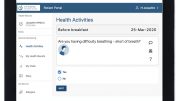It’s no secret that our healthcare system is under massive strain. Before the pandemic, problems caused by staff shortages, patient waiting lists, and a desire to drive efficiencies through digital transformation were already putting pressure on the NHS.
These problems have been exacerbated following the disruption caused by COVID-19. During the winter of 2021/22, research by the British Medical Association (BMA) estimated that the UK’s healthcare sector was short of 50,000 doctors – an average shortfall of more than 200 in every NHS trust.
There are reports, too, of workforce burnout reaching dangerous levels, with the Royal College of Physicians recently stating that 20% of its members feel overwhelmed at work every day. With further revelations from the BMA that many doctors are making plans to quit the NHS, it’s clear that steps need to be taken to avoid further attrition in the sector.
The cause of these problems is multi-faceted, but the solution may be less complex. During my time as a physician, my colleagues and I were consistently left frustrated by rostering schedules that provided little clarity over our working hours. Through a combination of erratic spreadsheets and rotas pinned to the backs of doors; we would receive our schedules with little time to plan for the weeks ahead.
Incredibly, progress in this area has gained little ground over the last 20 years, despite the rapid proliferation of smartphone devices and the widespread availability of the internet. But there are now tools available to overhaul doctor rostering, using mobile apps to provide doctors with a clearer picture of their working schedules.
Leveraging AI-powered technology, e-rostering solutions can shorten the time spent on doctor scheduling, reduce workforce burnout, and provide doctors with the visibility and flexibility they need to improve their work/life balance.
The ultimate beneficiaries, however, are patients themselves, receiving care from healthier, happier doctors.
A boon for healthcare managers
The most recent version of the NHS’s What Good Looks Like framework highlights how digital transformation can revolutionise the sector. Although the digitisation of doctor rostering may look like a small piece of the puzzle, the reality is that solving one problem in the NHS generally has a knock-on effect across the entire system.
For healthcare managers trying to compile rotas for their doctors, introducing the latest rostering technology can resolve three major scheduling headaches.
Firstly, aggregating doctor schedules across different Trust locations, specialisms, and levels of seniority is painstaking and difficult to achieve – particularly when managers attempt to take personal scheduling requests into account.
AI-based rostering systems not only remove this stress, but they can also produce comprehensive and accurate schedules within minutes. And when there’s a gap in the schedule, these systems can collate information from multiple sources and instantly find the solution.
Rostering technology also removes any difficulties involved in complying with Working Time Regulations – stipulations that limit workers in every sector to an average of 48 hours of work per week. For those working longer than six-hour days, a minimum of 11 hours of rest is required before their next shift starts.
As the NHS works through a patient backlog that will take years to clear, there is concern that doctors will inadvertently work beyond their legal limits. Automated rostering systems instantly meet working regulations, removing another headache for healthcare managers and protecting doctors from greater levels of burnout.
A boon for doctors
If you speak to doctors about their rotas, they’ll bemoan a lack of two things: transparency and flexibility. These two elements are essential if doctors are to achieve a better work/life balance.
When rosters are migrated to a mobile app, doctors can easily see their schedules and those of others. This enables them to quickly consult the schedule at any time and even request support from their colleagues, which could be vital when a patient requires specialist care.
And with greater flexibility in the system, doctors are in a better position to request leave, swap shifts, and make changes to their schedules. They can also receive instant notifications when changes to their schedules are made. Providing this level of self-service will help doctors regain control over their working lives.
Building transparency and flexibility into rostering will also instil a more cooperative approach to scheduling, giving doctors the sense that schedules are compiled with their input, as opposed to simply being forced upon them. Over time, this will cultivate a more trusting, loyal and motivated workforce.
New technologies are bringing cause for optimism right across the NHS. Replacing doctor rostering systems is already playing its part – bringing increased efficiency for planners, improving working conditions and providing an opportunity to stem the flow of doctors leaving the profession.
By Chris McCullough, former A&E physician at St Mary’s Hospital London and co-founder of Rotageek





